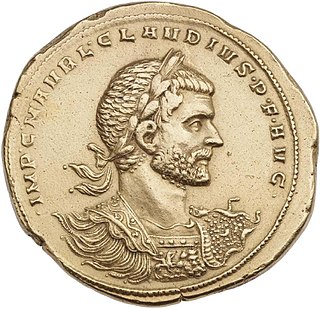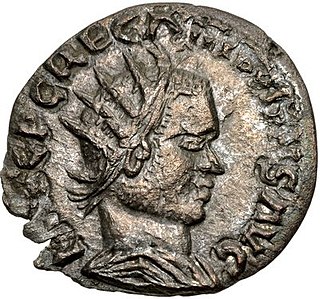
Publius Licinius Egnatius Gallienus was Roman emperor with his father Valerian from 253 to 260 and alone from 260 to 268. He ruled during the Crisis of the Third Century that nearly caused the collapse of the empire. He won numerous military victories against usurpers and Germanic tribes, but was unable to prevent the secession of important provinces. His 15-year reign was the longest in half a century.

Marcus Aurelius Claudius "Gothicus", also known as Claudius II, was Roman emperor from 268 to 270. During his reign he fought successfully against the Alemanni and decisively defeated the Goths at the Battle of Naissus. He died after succumbing to a "pestilence", possibly the Plague of Cyprian that had ravaged the provinces of the Empire.

Valerian was Roman emperor from 253 to spring 260 AD. Valerian is known as the first Roman emperor to have been taken captive in battle, captured by the Persian emperor Shapur I after the Battle of Edessa, causing shock and instability throughout the Roman Empire. The unprecedented event and the unknown fate of the captured emperor generated a variety of different reactions and "new narratives about the Roman Empire in diverse contexts".

Marcus Cassianius Latinius Postumus was a Roman commander of Batavian origin, who ruled as emperor of the splinter state of the Roman Empire known to modern historians as the Gallic Empire. The Roman army in Gaul threw off its allegiance to Gallienus around the year 260, and Postumus assumed the title and powers of Emperor in the provinces of Gaul, Germania, Britannia, and Hispania. He ruled for the better part of ten years before he was murdered by his own troops.

P. C. Regalianus, also known as Regalian, was Roman usurper for a few months in 260 and/or 261, during the Crisis of the Third Century, a period of intense political instability in the Roman Empire. Regalianus was acclaimed emperor by the troops along the Danube river, a region of the empire that frequently experienced barbarian raids, probably in the hope that he might be able to secure the frontier.

Titus Fulvius Iunius Macrianus, also known as Macrianus Minor, was a Roman usurper. He was the son of Fulvius Macrianus, also known as Macrianus Major.

Titus Fulvius Junius Quietus was a Roman usurper against Roman Emperor Gallienus.
Lucius Petronius Taurus Volusianus was a Roman citizen, apparently of equestrian origins, whose career in the Imperial Service in the mid-Third Century AD carried him from a relatively modest station in life to the highest public offices and senatorial status in a very few years. He may have secured his first appointments before the Licinian Dynasty – – acceded to the Empire in 253 AD, but it was in the course of their reign that his upward progress achieved an almost unprecedented momentum and the second factor seems to have been a consequence of the first. The nature of his relationship to the Licinii is uncertain, but it seems likely that a common origin in the Etruscan region of central Italy at least predisposed Gallienus in his favour and he seems to have been that emperor's most trusted servant and adviser during the period of his sole reign - 260(?)-268 AD.
Marinianus was Roman consul in 268 AD. He has been speculated to be the cousin, son or nephew of Roman Emperor Gallienus.
Sextus Cocceius Anicius Faustus Paulinus was a Roman senator who was appointed suffect consul sometime before AD 260/268.
Egnatius Lucillus was a Roman senator.
Flavius Antiochianus was a prominent Roman politician during the reigns of the emperors Gallienus, Claudius Gothicus, Quintillus and Aurelian, in the period referred to as the Crisis of the Third Century in the Roman Empire.
Virius Lupus was a consul of the Roman Empire in 278.
Gaius Junius Donatus was a Roman politician, who was appointed consul twice, the second time in AD 260, during the Crisis of the Third Century.
Publius Cornelius Saecularis was a Roman politician who was appointed consul twice, first in around AD 240 and later in AD 260, during the Crisis of the Third Century.
Ovinius Gaius Julius Aquilius Paternus was a Roman senator who was appointed consul in AD 267.
Aspasius Paternus was a Roman senator who was appointed consul twice.
Arcesilaus was a Roman senator who was appointed consul in AD 267.
Marcus Nummius Albinus was a Roman senator who was appointed consul twice, first as a suffectus sometime around AD 240, and secondly as an ordinarius in AD 263.
John Robert Martindale is a British historian specializing in the later Roman and Byzantine empires. Martindale's major publications are his magnum opus, the Prosopography of the Later Roman Empire, begun by A. H. M. Jones and published between 1971 and 1992, and the first part of Prosopography of the Byzantine Empire, which was published in 2001.






